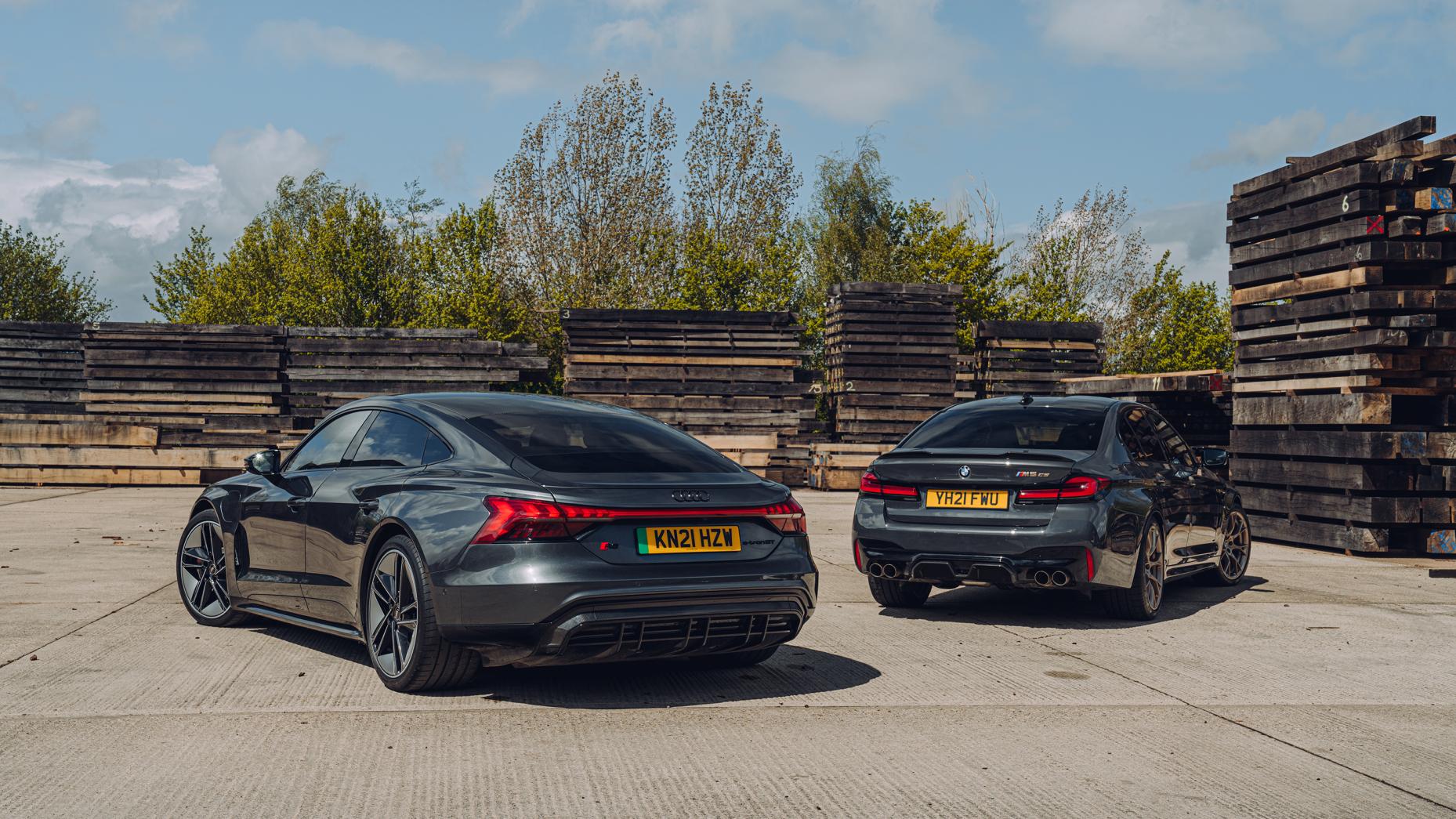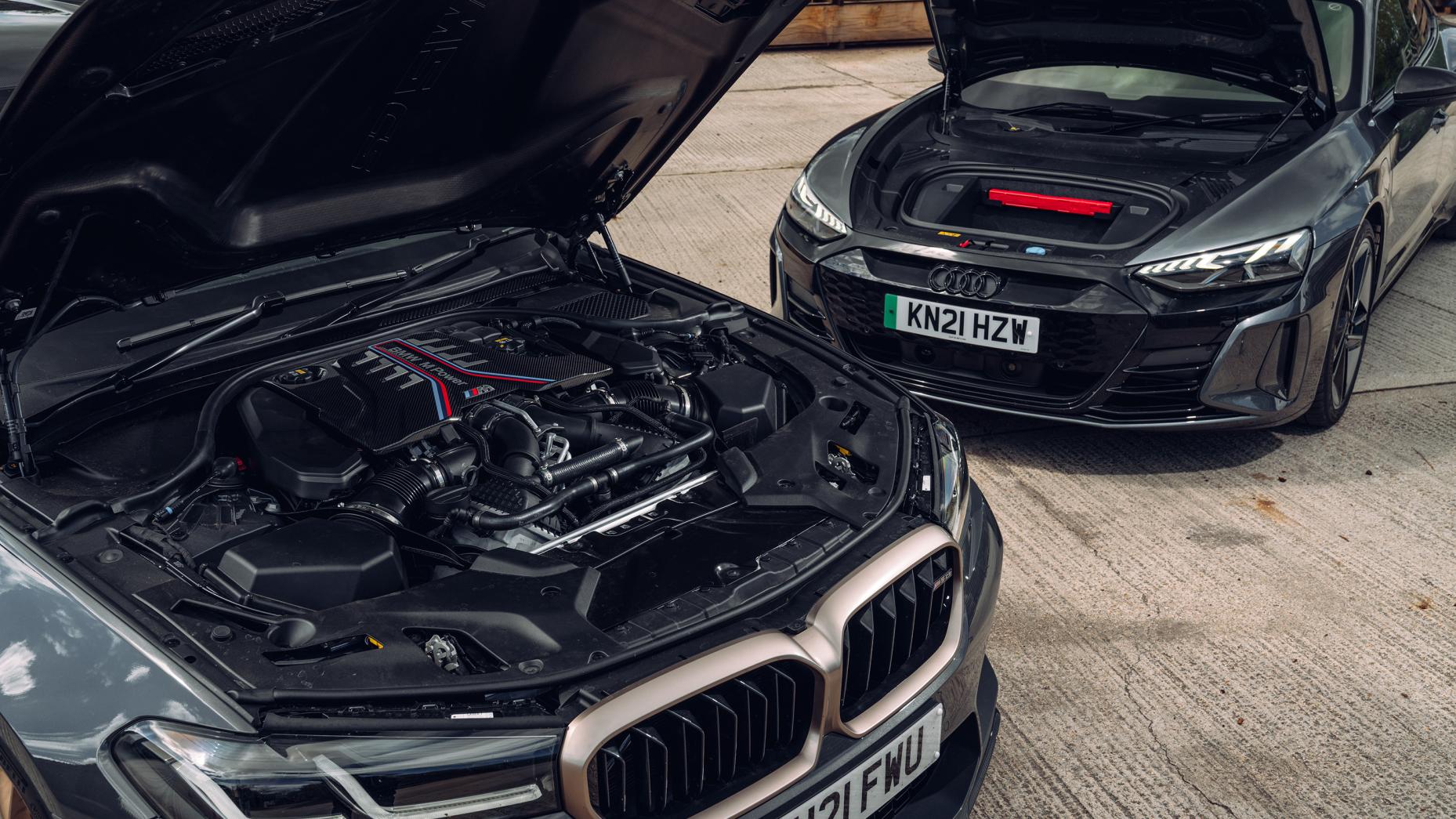Twin test: Audi RS e-tron GT vs BMW M5 CS

Words: Stephen Dobie Photography: Mark Riccioni
This looks like a slightly mismatched pair…
In their philosophy, yes. One is an iconic V8 four-door with everything cranked up to the max. The other is a brand-new electric car with grand touring pretensions. But both, at their core, are AWD, 600-odd horsepower German sports sedans that’ll hit 100kph in three seconds. It’s M Division versus RS, an age-old battle but on different terms.
In the grey corner, we have the new BMW M5 CS. It takes the stock M5’s twin-turbo V8 and cranks it up to 626bhp, making this the most powerful M car ever. Carbon panels, slimline buckets from the latest M3 and carbon-ceramic brakes all help shave 70 kilos from the portly M5. It’s still portly, just less so (at 1,825kg).
In the other grey corner, we have the Audi RS e-tron GT. Its Audi’s Tesla and Taycan rival in its (thus far) most powerful form, two motors and a 93kWh battery serving up 637bhp on overboost. It’s considerably chunkier than the M5, at 2,347kg, though it’s fair to say it doesn’t look as heavy as a Discovery and rarely feels it.
But pricey, huh...
Let’s start in the BMW, where quite a lot of its near forty grand (RM230k) climb over an M5 Competition - to a smidge over £140,000 (RM800k) - is won back with extremely special seats, front and back. Slimline carbon buckets that are a pricey option in the latest BMW M3 are standard fit here. And in each corner of the car. If you’re buying this for family duties, your kids will adore you for it. So long as you’ve only two and there’s not a third left forgotten at home Kevin McCallister style.
There’s also Alcantara in abundance and BMW’s latest suite of displays for the various M modes. Which is a mixed blessing – cycling the suspension, drivetrain and steering individually through their levels of boisterousness is no longer the work of a moment and requires a dive into a sub-menu. BMW’s slimming programme has also involved the central cubby hole being welded shut, which makes keeping your sunglasses and charging cables tidy very hard indeed.
And the Audi?
Prices start at a more palatable £110,000 (RM630k), though the car you see here is specced close to the M5. Inside it feels both much more intuitive while much less special, which ought to help explain just how sodding hard it must be to design a universally acclaimed car interior. By keeping rows of buttons for all of the GT’s key functions, Audi has undoubtedly won our hearts. This is no trickier to operate than a five-year old A3. But that does conversely rob this spangly new electric car of some razzmatazz.
Audi’s clearly looked at the Tesla Model S’s oversized central screen and uttered the German equivalent of ‘nahhh, you’re alright’. But in doing so it’s probably alienated those early EV adopters looking to try something new. There’s also very little RSiness to it – you could probably tell as much the fact its exterior panels (and crucially wheel arches) are the same as a base e-tron GT, and there’s no Alcantara inside like you’d usually find wrapped around almost every surface of an RS6 bar the windows. Instead there’s a bunch of recycled and sustainable fibres making up the carpets and seat trim.
Enough prodding. Get driving…
Let’s stick in the Audi. Quite how the engineers have made so much weight move forward so quickly and through corners so dextrously is astounding. Sure, the RS piles on some vital bits of tech that are optional further down the range – four-wheel steering and a rear differential lock help metaphorically trim some of the e-tron’s kilos – but it really is very impressive.
And just absurdly quick. Engage launch control and you’ll hit 100kph from a standstill in around three seconds. Which yes, is fifty per cent slower than a Model S Plaid, but I’ll happily admit to not caring one jot. In fact, two successive launches in the RS GT – one to sample launch control, a second to confirm “did that really just happen?” – was enough to discombobulate me for at least ten minutes. I don’t think I want to accelerate any faster. I certainly don’t need to.

Is it fun?
Rarely has a more pertinent question been asked. While much of the GT’s innards are shared with the Porsche Taycan, the e-tron feels tuned to be a different car. A comfier, plusher, more cocooning one. It’ll go round corners improbably quickly if you wish, its quattro system clawing uncanny amounts of grip in even wretched conditions as layers of ESP idiot-proof it all. I’m just not sure it’s all that engaging. The RS badges feel like a slightly duff fit, but then no more so than Turbo S badges do on a turbo-free Taycan. ‘G’ and ‘T’ are the more relevant letters on its rump.
It drives with latent sophistication and it’s rarely flummoxed by whatever you throw at it, but it stops short of genuine enjoyment once the instant torque tricks have worn thin (or made your head throb like a hangover).
Onto the BMW, then.
Here’s where the M5’s two levels of 4WD plus bonus 2WD drift mode show some relevance, the middle 4WD Sport option in particular. There’s more depth to your ginormous spend here, a handful of slightly different driving experiences all shoehorned into one car.
Quite how much of its performance can be truly freed on the road is a debate for elsewhere, just know that it’s easily the most satisfying M5 in years. Alright, it’s taken a near-£40k (RM230k) leap and lightweight, four-seat CS treatment for this F90 M5 to have a hope of beating the effortlessly brilliant Mercedes-AMG E63, perhaps proving a total M5 metamorphosis is due. One that’ll likely see its bulk swell further as it takes batteries on board.
What makes it feel special?
A super sedan usually sells on some level of subtlety, but like a two-seat trackday hot hatch, this CS stands out by losing some of its apparent reason for being. The more specialised nature of this M5 is what makes it such an alluring item. Its copper detailing will split a room even more than the Nürburgring pig’s heads etched into all four headrests, but its chintz will be the very detail that makes your head swivel on the odd occasion it passes you by.
Which might be a little more often than you think – despite its stocky price this isn’t a limited edition. Perhaps it’ll be one to look out for in three years’ time, tantalisingly priced in the classifieds.
How does it compare to the e-tron?
Here’s what I didn’t expect. After a long weekend swishing around in the Audi, the BMW can’t help but feel like a gargling dinosaur. Which is both praise and criticism. Those toddlers hyperventilating with excitement in its rear buckets likely also know their Allosaurus from their Tyrannosaurus, after all. It’s all just a bit uncouth, which is part of the mischievous appeal of an M car, but also something that – in the presence of a spellbindingly quick EV – perhaps feels like it rightfully now has a shelf life.
The sports sedan schtick was traditionally supercar pace in a sensible body -speed with subtlely. And perhaps that makes this corner of the market a natural home for batteries and motors. While some truly mesmeric powerplants have powered AMG, M and RS models over the years – think 6.2-litre AMGs, 4.2-litre RS4s and the fantastically flawed V10 M5 – electric powertrains are something four-doors can more naturally explore than hot hatches (whose weight may spiral disproportionately out of control) and supercars (whose significantly more specialised nature surely makes their CO2 emissions a bit less relevant).

So what’s the verdict?
While we hate to be cop-outs, picking a winner isn’t especially fair. The M5 CS may end up being petrol-powered M cars at their pricey zenith, while the e-tron GT is Audi Sport’s first toe in electric waters. There’s a rather large gap in driving satisfaction here that betrays where each car sits on its respective timeline.
What’s more illustrative is that while the M5 undoubtedly makes my grin much wider, I think I prefer the e-tron as a road car. After becoming accustomed to slipping around without noise or fuss in the GT, I felt a bit encumbered by the CS’s noise and fuss.
Electric edges it?
Almost. I’m just not sure the RS feels special enough that I’d make the leap. The challenge it faces is perhaps inevitable. Jumping from a £30k (RM170k) hatch to a £140k (RM800k) sedan in the petrol performance car market means doubling the cylinders and gaining a bassier sound, sharper throttle response and a much more sophisticated gearbox.
In short, lots of tangible drama you don’t need to corner with several G to appreciate. Just starting up on a morning feels special. Electric cars can’t yet offer that – for all the e-tron’s surprisingly appealing symposed sound, its general ambience and throttle response aren’t far off a Renault Zoe’s, just with considerably more performance built in.
What I’d really love is a car that combines the best of both worlds – an outrageously powerful electric sedan with a good chunk of the CS’s gnarly attitude. More dramatic EVs will come, I’m sure, as battery technology and charging infrastructure improves and the engineers can avert their gaze from maximising range to inject some swagger into their cars. The RS e-tron GT isn’t perfect, but it’s a promising step on the way there.

Audi RS e-tron GT
£132,625 (RM760k) as tested
Two e-motors, 637bhp, 830Nm
0-100kph in 3.3secs, 250kph top speed
472 kilometres range, 0g/km
4WD, 2spd auto
2347kg
BMW M5 CS
£140,780 (RM810k) as tested
4.4-litre twin-turbo V8, 626bhp, 750Nm
0-100kph in 3.0secs, 304kph top speed
10.5l/100km, 249g/km
4WD, 8spd auto
1825kg













